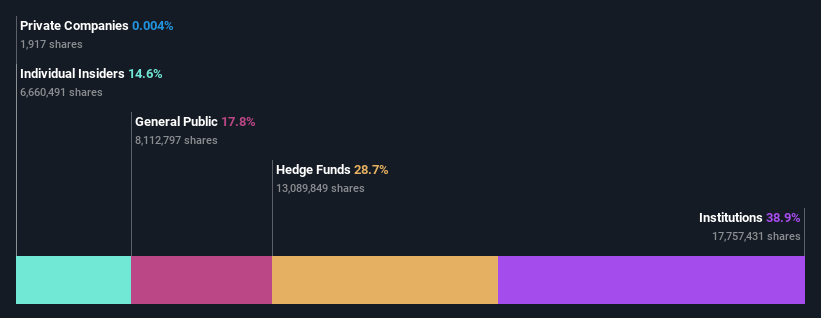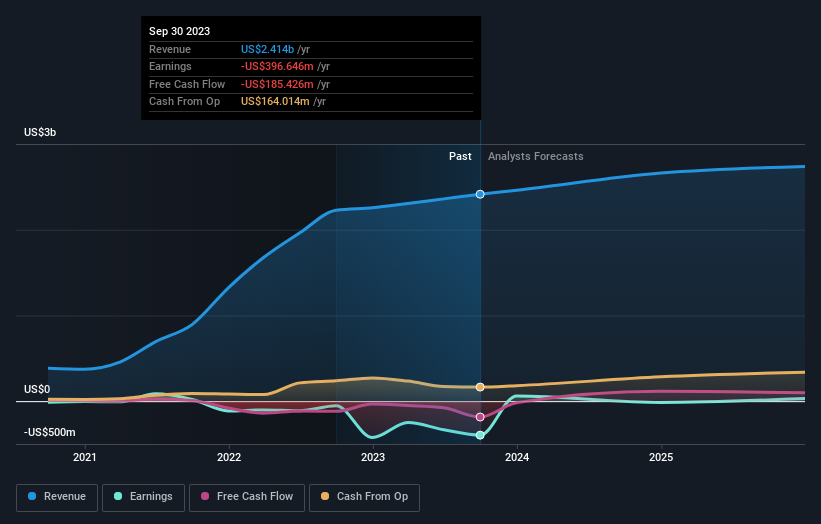Bally's Corporation (NYSE:BALY) institutional owners may be pleased with recent gains after 42% loss over the past year
Key Insights
Given the large stake in the stock by institutions, Bally's' stock price might be vulnerable to their trading decisions
53% of the business is held by the top 5 shareholders
Every investor in Bally's Corporation (NYSE:BALY) should be aware of the most powerful shareholder groups. And the group that holds the biggest piece of the pie are institutions with 39% ownership. That is, the group stands to benefit the most if the stock rises (or lose the most if there is a downturn).
Last week's US$57m market cap gain would probably be appreciated by institutional investors, especially after a year of 42% losses.
In the chart below, we zoom in on the different ownership groups of Bally's.
Check out our latest analysis for Bally's
What Does The Institutional Ownership Tell Us About Bally's?
Institutional investors commonly compare their own returns to the returns of a commonly followed index. So they generally do consider buying larger companies that are included in the relevant benchmark index.
As you can see, institutional investors have a fair amount of stake in Bally's. This implies the analysts working for those institutions have looked at the stock and they like it. But just like anyone else, they could be wrong. If multiple institutions change their view on a stock at the same time, you could see the share price drop fast. It's therefore worth looking at Bally's' earnings history below. Of course, the future is what really matters.
Our data indicates that hedge funds own 29% of Bally's. That's interesting, because hedge funds can be quite active and activist. Many look for medium term catalysts that will drive the share price higher. Standard General L.P. is currently the largest shareholder, with 23% of shares outstanding. Meanwhile, the second and third largest shareholders, hold 11% and 9.5%, of the shares outstanding, respectively. Additionally, the company's CEO Robeson Reeves directly holds 0.7% of the total shares outstanding.
On looking further, we found that 53% of the shares are owned by the top 5 shareholders. In other words, these shareholders have a meaningful say in the decisions of the company.
Researching institutional ownership is a good way to gauge and filter a stock's expected performance. The same can be achieved by studying analyst sentiments. Quite a few analysts cover the stock, so you could look into forecast growth quite easily.
Insider Ownership Of Bally's
The definition of an insider can differ slightly between different countries, but members of the board of directors always count. The company management answer to the board and the latter should represent the interests of shareholders. Notably, sometimes top-level managers are on the board themselves.
Insider ownership is positive when it signals leadership are thinking like the true owners of the company. However, high insider ownership can also give immense power to a small group within the company. This can be negative in some circumstances.
It seems insiders own a significant proportion of Bally's Corporation. It has a market capitalization of just US$516m, and insiders have US$75m worth of shares in their own names. We would say this shows alignment with shareholders, but it is worth noting that the company is still quite small; some insiders may have founded the business. You can click here to see if those insiders have been buying or selling.
General Public Ownership
The general public-- including retail investors -- own 18% stake in the company, and hence can't easily be ignored. While this size of ownership may not be enough to sway a policy decision in their favour, they can still make a collective impact on company policies.
Next Steps:
It's always worth thinking about the different groups who own shares in a company. But to understand Bally's better, we need to consider many other factors. Consider risks, for instance. Every company has them, and we've spotted 1 warning sign for Bally's you should know about.
If you are like me, you may want to think about whether this company will grow or shrink. Luckily, you can check this free report showing analyst forecasts for its future.
NB: Figures in this article are calculated using data from the last twelve months, which refer to the 12-month period ending on the last date of the month the financial statement is dated. This may not be consistent with full year annual report figures.
Have feedback on this article? Concerned about the content? Get in touch with us directly. Alternatively, email editorial-team (at) simplywallst.com.
This article by Simply Wall St is general in nature. We provide commentary based on historical data and analyst forecasts only using an unbiased methodology and our articles are not intended to be financial advice. It does not constitute a recommendation to buy or sell any stock, and does not take account of your objectives, or your financial situation. We aim to bring you long-term focused analysis driven by fundamental data. Note that our analysis may not factor in the latest price-sensitive company announcements or qualitative material. Simply Wall St has no position in any stocks mentioned.


